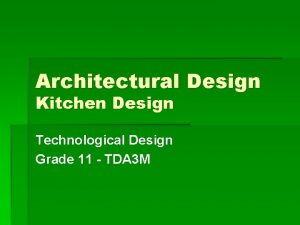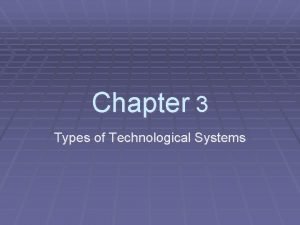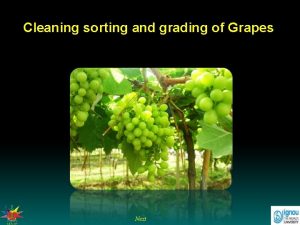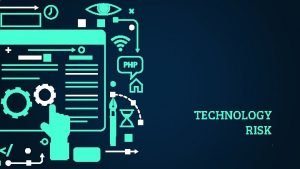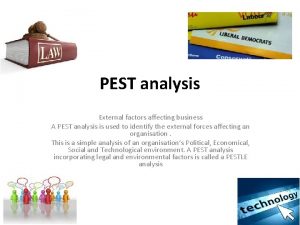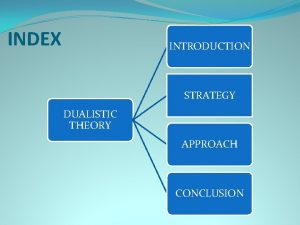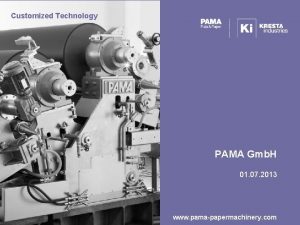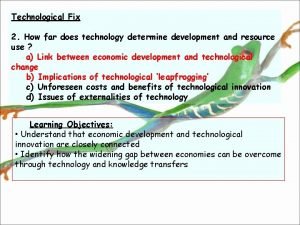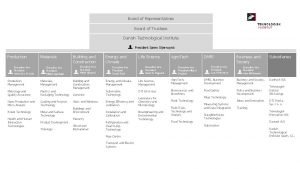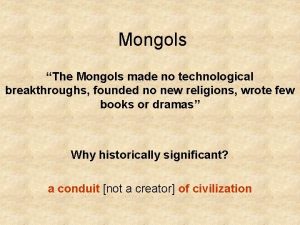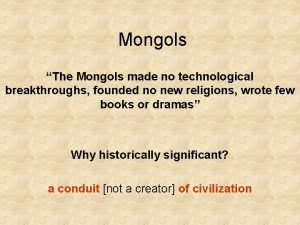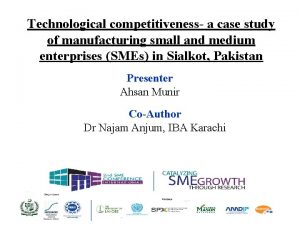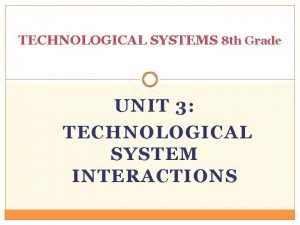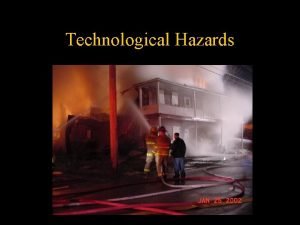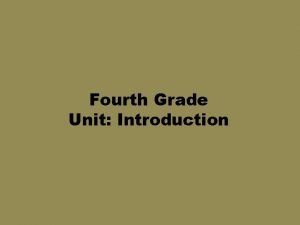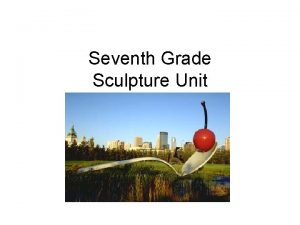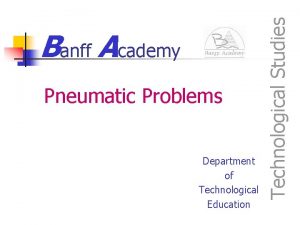TECHNOLOGICAL SYSTEMS 8 TH GRADE Unit 1 Technological










































- Slides: 42

TECHNOLOGICAL SYSTEMS 8 TH GRADE Unit 1 Technological Systems: How They Work J. Kush 8 -2010

BY THE END OF THE UNIT YOU WILL… Understand what systems are Know why systems are developed How “systems thinking” can be used to describe them Create a systems model graphic to analyze a system Realize that the stability of a system is influenced by all of the components in the system

WHAT IS A SYSTEM? A system is a group of interrelated components or parts that collectively achieve a desired result.

WHAT IS A SYSTEM? A system is a group of interrelated components or parts that collectively achieve a desired result. TO KEEP IT SIMPLE: A system is a team that works together to achieve a goal

WHAT IS A SYSTEM? A system is a group of interrelated components or parts that collectively achieve a desired result. TO KEEP IT SIMPLE: A system is a team that works together to achieve a goal.

WHAT IS A SYSTEM? A system is a group of interrelated components or parts that collectively achieve a desired result. TO KEEP IT SIMPLE: A system is a team that works together to achieve a goal. Think about a computer system.

WHAT IS A SYSTEM? (GROUP TIME) A system is a group of interrelated components or parts that collectively achieve a desired result. *What are the parts of a computer system? *How are the parts connected together? *What is the job of each part? *What is the goal of the entire system? *What will happen if one of the parts does not work? *Why do the parts of the system depend on each other? *How does this system make life better?

SMALL GROUP ACTIVITY COMPARE AND CONTRAST NATURAL AND MAN MADE SYSTEMS Human Anatomy Subsystems Respiratory System • Automobile Subsystems Power Train System • Electrical System • Coolant System Cardiovascular System Skeletal System • Fuel System Digestive System • Safety System • Exhaust System • Brake System • Steering System Nervous System Muscular System

WHAT HAPPENS IN A SYSTEM? UNIVERSAL SYSTEMS MODEL

UNIVERSAL SYSTEMS MODEL Inputs are things put into the system to make it function. Car Example: What are some inputs needed for a car?

UNIVERSAL SYSTEMS MODEL Inputs are things put into the system to make it function. Car Example: What are some inputs needed for a car? GASOLINE

UNIVERSAL SYSTEMS MODEL GASOLINE Processes are something that is done to the inputs to make something happen. It is an action. Car Example: What happens to the gasoline when it is processed in a car?

UNIVERSAL SYSTEMS MODEL GASOLINE COMBUSTION & TRANSMISSION Processes are something that is done to the inputs to make something happen. It is an action. Car Example: What happens to the gasoline when it is processed in a car? Answer: The gasoline combusts or explodes in the engine causing pistons to move up and down. That energy is then transferred to the transmission that then transfers the energy with mechanical advantage to the axels.

UNIVERSAL SYSTEMS MODEL GASOLINE COMBUSTION & TRANSMISSION Output is what happens when the inputs are processed. Car Example: What happens when the axels turn the wheels on a car?

UNIVERSAL SYSTEMS MODEL GASOLINE COMBUSTION & TRANSMISSION Output is what happens when the inputs are processed. Car Example: What happens when the axels turn the wheels on a car? IT MOVES!

UNIVERSAL SYSTEMS MODEL GASOLINE COMBUSTION & TRANSMISSION Outputs can also be negative or bad. What is a negative output from a car when it is running? IT MOVES!

UNIVERSAL SYSTEMS MODEL GASOLINE IT MOVES! COMBUSTION & TRANSMISSION Exhaust Fumes Outputs can also be negative or bad. What is a negative output from a car when it is running? Answer: Exhaust fumes that pollute the air we breath.

UNIVERSAL SYSTEMS MODEL GASOLINE COMBUSTION & IT MOVES! TRANSMISSION Exhaust Fumes Feedback is when the system gives information

UNIVERSAL SYSTEMS MODEL GASOLINE COMBUSTION & IT MOVES! TRANSMISSION Exhaust Fumes The Gas Gauge tells us how much fuel is left. The Speedometer tells us how fast we are Traveling in the car.

HOME HEATING SYSTEM Think about how your house is heated at home. Draw a diagram of its system model.

CUP & STRING COMMUNICATION Does it really work? If it does, how does it work? J Kush 9 -2010

SOME FACTS YOU NEED TOKNOW: Natural and human-made objects are made up of parts. Systems are made of parts that work together. A system is made from INPUTS, PROCESSES, OUTPUTS, and FEEDBACK Systems are used to accomplish a goal.

MORE ABOUT SYSTEMS… Systems are found in nature, and some are made by humans. Examples: ?

MORE ABOUT SYSTEMS… Systems are found in nature, and some are made by humans. Examples:

MORE ABOUT SYSTEMS… Systems are found in nature, and some are made by humans. Examples: Hydrologic Cycle

MORE ABOUT SYSTEMS… Systems are found in nature, and some are made by humans. Examples: Hydrologic Cycle ? ? ?

MORE ABOUT SYSTEMS… Systems are found in nature, and some are made by humans. Examples: Hydrologic Cycle Natural Cycle of Life

MORE ABOUT SYSTEMS… Systems are found in nature, and some are made by humans. Examples: Hydrologic Cycle Natural Cycle of Life ? ? ?

MORE ABOUT SYSTEMS… Systems are found in nature, and some are made by humans. Examples: Hydrologic Cycle Natural Cycle of Life Cycle of a Butterfly

MORE ABOUT SYSTEMS… A subsystem is a system that operates as part of another system. It is like a component that works in a system. It has its own inputs, process, outputs, and feedbacks. Examples: ? ? ?

MORE ABOUT SYSTEMS… A subsystem is a system that operates as part of another system. It is like a component that works in a system. It has its own inputs, process, outputs, and feedbacks. Example: a controller in a video game system

MORE ABOUT SYSTEMS… A subsystem is a system that operates as part of another system. It is like a component that works in a system. It has its own inputs, process, outputs, and feedbacks. Example: a controller in a video game system What would be the… Inputs? Processes? Outputs? Feedback?

MORE ABOUT SYSTEMS… A subsystem is a system that operates as part of another system. It is like a component that works in a system. It has its own inputs, process, outputs, and feedbacks. Example: a controller in a video game system INPUTS? PROCESSES? OUTPUTS? FEEDBACK?

MORE ABOUT SYSTEMS… When parts of a system are missing or malfunctioning, the system may not work properly. What would happen if… The engine in a car stopped working? The keyboard on you computer was broken? The ear bud cord on you MP 3 player was cut? Your login password was not accepted?

MORE ABOUT SYSTEMS… Any system is usually connected to other systems, both internally and externally. A system may be thought of as containing subsystems and as being a subsystem of a larger system.

MORE ABOUT SYSTEMS… Any system is usually connected to other systems, both internally and externally. A system may be thought of as containing subsystems and as being a subsystem of a larger system.

MORE ABOUT SYSTEMS… Mechanical systems take an input motion or force and create a desired output motion of force.

MORE ABOUT SYSTEMS… Mechanical systems take an input motion or force and create a desired output motion of force. Examples: door latch

MORE ABOUT SYSTEMS… Mechanical systems take an input motion or force and create a desired output motion of force. Examples: door latch pulleys

MORE ABOUT SYSTEMS… Mechanical systems take an input motion or force and create a desired output motion of force. Examples: door latch pulleys gears Which way will the last gear turn? CW or CCW

MORE ABOUT SYSTEMS… Mechanical systems take an input motion or force and create a desired output motion of force. Examples: door latch pulleys gears Which way will the last gear turn? CW

MORE ABOUT SYSTEMS…
 Kitchen design
Kitchen design Types of technological systems
Types of technological systems Unit 6 review questions
Unit 6 review questions Up grading system
Up grading system First grade angels second grade tots
First grade angels second grade tots Culinary
Culinary Milk grades
Milk grades Grading of grapes
Grading of grapes Low grade and high grade metamorphic rocks
Low grade and high grade metamorphic rocks Visvesvaraya technological university nagpur
Visvesvaraya technological university nagpur Technology discontinuity
Technology discontinuity Definition of technology risk
Definition of technology risk Technological modelling
Technological modelling Technological leader
Technological leader Technological gap and product cycle model
Technological gap and product cycle model Technological design process
Technological design process Political economic
Political economic Institute for prospective technological studies
Institute for prospective technological studies Example of technological convergence
Example of technological convergence Importance of technological innovation
Importance of technological innovation Internal environment of a business
Internal environment of a business Teori technological determinism
Teori technological determinism Technological dualism
Technological dualism External factors affecting tesco
External factors affecting tesco Technology forecasting
Technology forecasting Technological dualism
Technological dualism Five things we need to know about technological change
Five things we need to know about technological change Pama technological support
Pama technological support Ufa state petroleum technical university
Ufa state petroleum technical university Ascoulor
Ascoulor Contoh kasus technological determinism theory
Contoh kasus technological determinism theory Which is one limitation to technological design
Which is one limitation to technological design Scientific vs technical
Scientific vs technical 5 major technological trajectories
5 major technological trajectories 5 technological processes
5 technological processes Technological university of tajikistan
Technological university of tajikistan Technological fix definition
Technological fix definition Latvian technological center
Latvian technological center Danish technological university
Danish technological university Technological literacy definition
Technological literacy definition The mongols made no technological breakthroughs
The mongols made no technological breakthroughs The mongols made no technological breakthroughs
The mongols made no technological breakthroughs Technological competitiveness
Technological competitiveness
